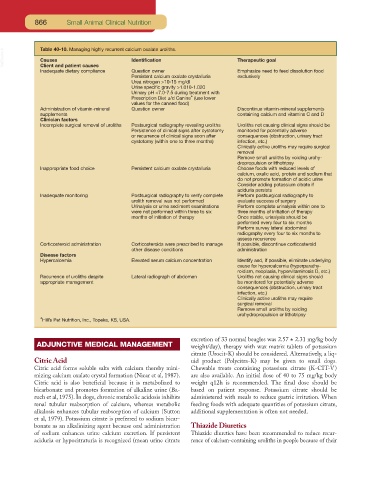Page 835 - Small Animal Clinical Nutrition 5th Edition
P. 835
866 Small Animal Clinical Nutrition
VetBooks.ir Table 40-10. Managing highly recurrent calcium oxalate uroliths. Therapeutic goal
Identification
Causes
Client and patient causes
Inadequate dietary compliance Question owner Emphasize need to feed dissolution food
Persistent calcium oxalate crystalluria exclusively
Urea nitrogen >10-15 mg/dl
Urine specific gravity >1.010-1.020
Urinary pH <7.0-7.5 during treatment with
Prescription Diet u/d Canine* (use lower
values for the canned food)
Administration of vitamin-mineral Question owner Discontinue vitamin-mineral supplements
supplements containing calcium and vitamins C and D
Clinician factors
Incomplete surgical removal of uroliths Postsurgical radiography revealing uroliths Uroliths not causing clinical signs should be
Persistence of clinical signs after cystotomy monitored for potentially adverse
or recurrence of clinical signs soon after consequences (obstruction, urinary tract
cystotomy (within one to three months) infection, etc.)
Clinically active uroliths may require surgical
removal
Remove small uroliths by voiding urohy-
dropropulsion or lithotripsy
Inappropriate food choice Persistent calcium oxalate crystalluria Choose foods with reduced levels of
calcium, oxalic acid, protein and sodium that
do not promote formation of acidic urine
Consider adding potassium citrate if
aciduria persists
Inadequate monitoring Postsurgical radiography to verify complete Perform postsurgical radiography to
urolith removal was not performed evaluate success of surgery
Urinalysis or urine sediment examinations Perform complete urinalysis within one to
were not performed within three to six three months of initiation of therapy
months of initiation of therapy Once stable, urinalysis should be
performed every four to six months
Perform survey lateral abdominal
radiography every four to six months to
assess recurrence
Corticosteroid administration Corticosteroids were prescribed to manage If possible, discontinue corticosteroid
other disease conditions administration
Disease factors
Hypercalcemia Elevated serum calcium concentration Identify and, if possible, eliminate underlying
cause for hypercalcemia (hyperparathy-
roidism, neoplasia, hypervitaminosis D, etc.)
Recurrence of uroliths despite Lateral radiograph of abdomen Uroliths not causing clinical signs should
appropriate management be monitored for potentially adverse
consequences (obstruction, urinary tract
infection, etc.)
Clinically active uroliths may require
surgical removal
Remove small uroliths by voiding
urohydropropulsion or lithotripsy
*Hill’s Pet Nutrition, Inc., Topeka, KS, USA.
excretion of 33 normal beagles was 2.57 ± 2.31 mg/kg body
ADJUNCTIVE MEDICAL MANAGEMENT weight/day), therapy with wax matrix tablets of potassium
citrate (Urocit-K) should be considered. Alternatively, a liq-
Citric Acid uid product (Polycitra-K) may be given to small dogs.
Citric acid forms soluble salts with calcium thereby mini- Chewable treats containing potassium citrate (K-CIT-V)
mizing calcium oxalate crystal formation (Nicar et al, 1987). are also available. An initial dose of 40 to 75 mg/kg body
Citric acid is also beneficial because it is metabolized to weight q12h is recommended. The final dose should be
bicarbonate and promotes formation of alkaline urine (Ba- based on patient response. Potassium citrate should be
ruch et al, 1975). In dogs, chronic metabolic acidosis inhibits administered with meals to reduce gastric irritation. When
renal tubular reabsorption of calcium, whereas metabolic feeding foods with adequate quantities of potassium citrate,
alkalosis enhances tubular reabsorption of calcium (Sutton additional supplementation is often not needed.
et al, 1979). Potassium citrate is preferred to sodium bicar-
bonate as an alkalinizing agent because oral administration Thiazide Diuretics
of sodium enhances urine calcium excretion. If persistent Thiazide diuretics have been recommended to reduce recur-
aciduria or hypocitraturia is recognized (mean urine citrate rence of calcium-containing uroliths in people because of their

